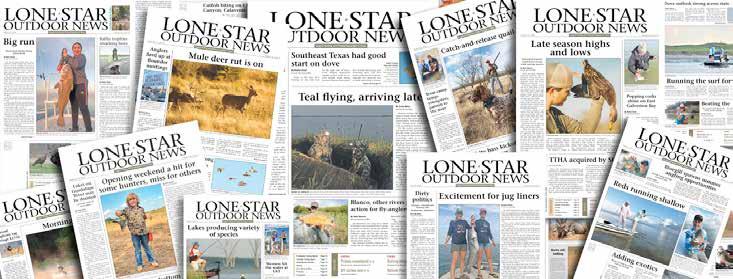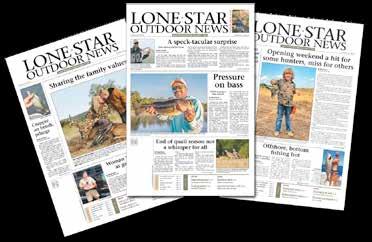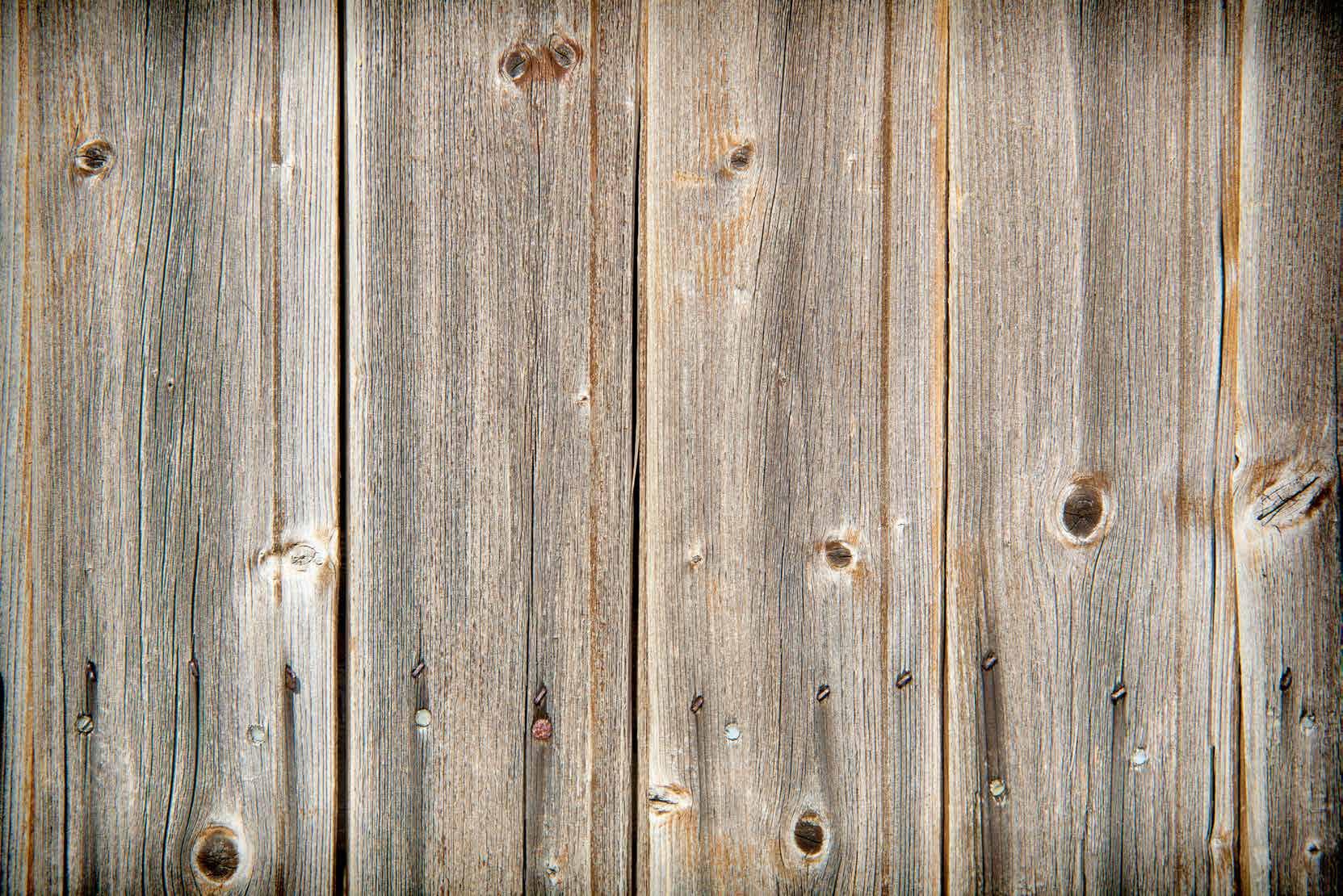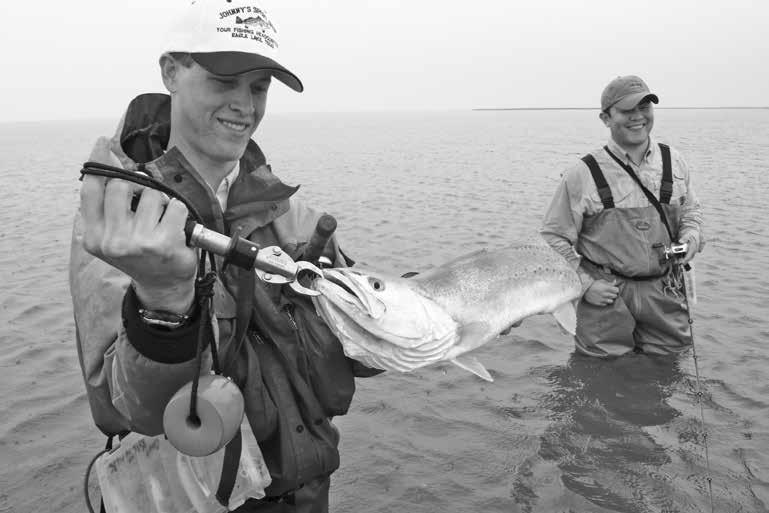
8 minute read
Game Warden Blotter
FROM TRASH DUMPING TO LIST OF CRIMES
An illegal dumping complaint at a local restaurant was reported to a Gregg County game warden. The restaurant owner reported numerous rancid bags of trash, accompanied by a decaying white-tailed doe carcass missing only its backstraps, piled around their business and dumpster. Information gathered matched an individual who the warden was already investigating on unrelated hunting violations. The warden and local officers responded to the subject’s residence where he and fellow tenants advised they had deemed the spoiled doe inedible via damages from a vehicle vs. deer incident. An impromptu necropsy suggested otherwise, prompting a confession of how the doe was shot out of season and allowed to waste. During that interview, an additional confession was also collected regarding the warden’s original hunting investigation. That individual confirmed the illegal harvest of two other bucks found with antlers entangled from sparring along a late-night roadway. Exhausted and struggling to flee danger, both deer were stabbed by the individual. Civil restitution and multiple subjects were charged.
Advertisement
BUCK TAKEN OUT OF SEASON, ALLOWED TO SPOIL
A Travis County game warden received a call from a processor reporting a man with a deer intact (not gutted) and most likely spoiled. The individual stated to the processor, “I guess I’ll go dump this then.” The warden was unable to find a local address for the suspect but was able to call him while he was returning to Houston. The individual said his friend shot an 8-point buck the previous afternoon. The warden contacted the landowner, who shot the deer, and informed him he faced a waste of game charge for leaving the buck for more than 24 hours in temperatures exceeding 70 degrees. The warden also made the landowner aware that the general season ended two weeks prior and the buck was taken illegally. The violator then responded with an expletiveladen statement indicating his guilt. The warden seized the antlers from a taxidermist. Charges and civil restitution pending.
BAD TIME TO GET STUCK
When responding to a trespassing call from a landowner, a McLennan County game warden came upon a subject stuck in the mud. The warden discovered that the man in the vehicle had also burglarized a vehicle while trespassing. The landowner identified the stolen property and it was returned. The suspect was arrested for burglary of a vehicle and criminal trespass.
COOPERATING SPOUSES
A DeWitt County game warden received a complaint about a person suspected of taking a deer out of season. When the suspect was contacted, her husband’s tag was on the deer. The husband initially claimed to have shot the deer. After interviewing both individuals, it was determined the wife had shot the deer. It was not taken out of season, but it was taken without a license. When all was said and done, violations included hunting without a license, hunting under the license of another, allowing another to hunt under one’s license, no proof of sex, and no hunters education. The deer was seized and donated.
HUNTING NEXT TO THE INTERSTATE
In the Tony Housman Wildlife Management Area, an Orange County game warden observed a vehicle driving along the right-of-way in a construction zone. A shotgun was located on the dashboard. The warden exited the interstate at the state line and made his way back along the right-of-way to investigate. As he approached the vehicle, he observed a male subject carrying a shotgun coming from the woods, which is a closed area of the WMA. During the contact, the subject claimed he was hunting hogs and was looking for a stand that his friend had erected next to the interstate. The warden found the stand erected on the WMA property within just a few feet of the interstate. The subject was issued citations for no annual public hunting permit and no hunting license. Two wardens followed up with the friend who had illegally placed the stand. That subject confessed to placing the stand in the closed area of the WMA and was cited.
REPORT ILLEGAL HUNTING AND FISHING ACTIVITY FOR A REWARD OF UP TO $1,000. CALL OPERATION GAME THIEF AT (800) 792-4263
AN AMERICAN LEGEND
RUGER.COM/AMERICANRIFLE
THE PAPER YOU LOVE


S U B S C R I B E T O R E C E I V E T H E B E S T H U N T I N G A N D F I S H I N G N E W S D E L I V E R E D S T R A I G H T T O Y O U R M A I L B O X T E X A S L A R G E S T H U N T I N G F I S H I N G


N E W S P A P E R S I N C E 2 0 0 4
1 YEAR 24 issues
$35
2 YEARS
48 issues
$65
3 YEARS 72 issues
LIFETIME $95
$500
NAME
ADDRESS
CITY/STATE/ZIP
PHONE
CREDIT CARD NO.
EXP. DATE
CVV
BILLING ZIP CODE
SIGNATURE
CUT OUT THIS SUBSCRIPTION FORM AND MAIL TO: LONE STAR OUTDOOR NEWS P.O. BOX 551695 DALLAS, TX 75355
SUBSCRIPTIONS ALSO AVAILABLE ONLINE OR BY PHONE.
NEW GIFT RENEWAL
MAKE CHECKS PAYABLE TO LONE STAR OUTDOOR NEWS.
$35 ALL SUB TH SC E R NEW IBE S YOU TOD N A EE Y D T FR O O L M O THE NE S S O T URC AR E YOU TRUS OUTDOO T. R NEWS FOR SUBS A 1 CRI YEAR PTION CALL (214) 361-2276 LSONEWS.COM
Rules on specks
Continued from page 1

Gillnet surveys will give officials a better picture of the extent of the speckled trout kill in Texas bays. Photo by Lone Star Outdoor News.
Department’s Director of Coastal Fisheries, told the commission the changes would result in a 27-percent increase in the spawning stock biomass over current limits, although it takes two years to accomplish those results.
“The changes would help keep fish in the water through the spawning season (late April through September),” he said.
The emergency action will be reevaluated once additional data is gathered by Coastal Fisheries biologists during the spring sampling season. This information will provide a better indication of the freeze impact to fish populations.
“I am confident that our spring sampling will help us get a better picture of the impacts to fish populations since the February fish kill event,” Reichers said.
After the announcement of the changes, questions began pouring in from anglers and fishing guides.
Many asked if the changes could be made permanent.
Reichers told Lone Star Outdoor News not under the Emergency Rule, and changes beyond the Emergency Rule 120-day period, plus possibly a 60-day extension, would have to go through the normal regulatory process, which includes public comment periods, public meetings, and normally takes at least 90 days.
Midcoast anglers and guides from the Matagorda bay systems to Port Aransas were disappointed the Emergency Rule didn’t apply to their areas.
Could the spring gillnet surveys cause the department to reconsider midcoast areas?
“They absolutely could,” Reichers said. “By July, we’ll have a better picture of what the full impacts were to the different bay systems. We will know the overall trend and abundance, and we’ll have information about size classes. At that point, the suite of different ways to make rule-making would still be available.”
The gillnet surveys will begin in midApril and end in early June. Early estimates used for the size of the fish kill were based on a phased approach including the geographic extent and distribution of fish and a rapid assessment to determine rough estimates of the number of fish killed and species impacted based on American Fisheries Society guidelines for sampling.
“We have used this type of approach internally for years for things like red tide,” Reichers said.
Since the freeze was so impactful, Reichers said the department wanted to share the estimates with the public.
The assessment of 3.8 million fish killed compares with 6.2 million in the December 1989 freeze, 11.3 million in the February 1989 freeze and 14.4 million in the 1983 freeze.
“We believe (the 3.8 million) is a minimum estimate,” Reichers said.
While 3.2 million of the estimate was nongame fish like silver perch, hardhead catfish, pinfish, bay anchovy and striped mullet, Reichers said the impact was important.
“The nongame fish are a foundation for the ecosystem,” he said.
One angler asked on Instagram, “Will the fish be starving due to the lack of baitfish since the kills were so large?”
Reichers didn’t think so.
Recovery doesn’t mean the trophy-sized fish will be back that quickly, though.
Reichers told the commission that several items will be assessed in dealing with future freeze events, including the requesting of voluntary suspension of barge traffic operations.
“They were very cooperative for the most part,” he said.
Other efforts will include expanding the use of citizen science; assessing the timing and size of closures and whether closures should be extended to allow fish to leave their thermal refuge areas; and increasing hatchery production.





